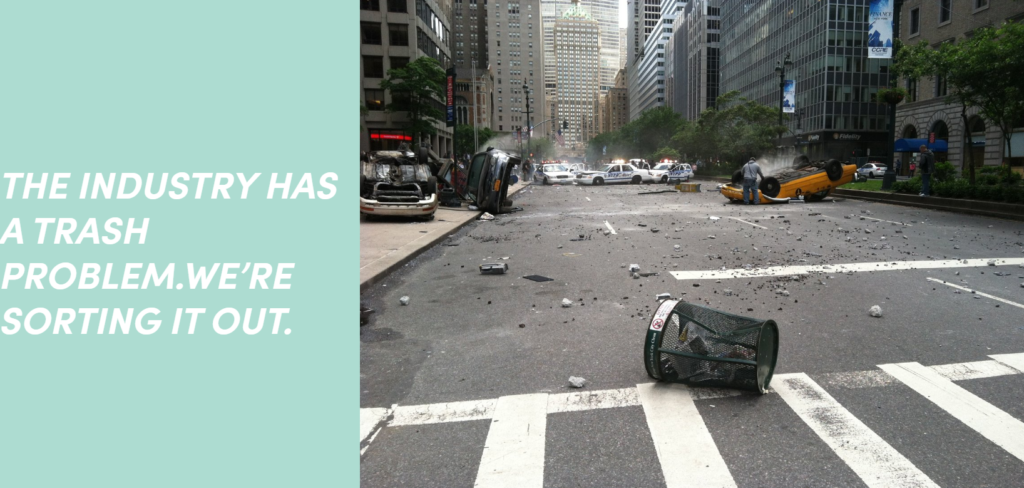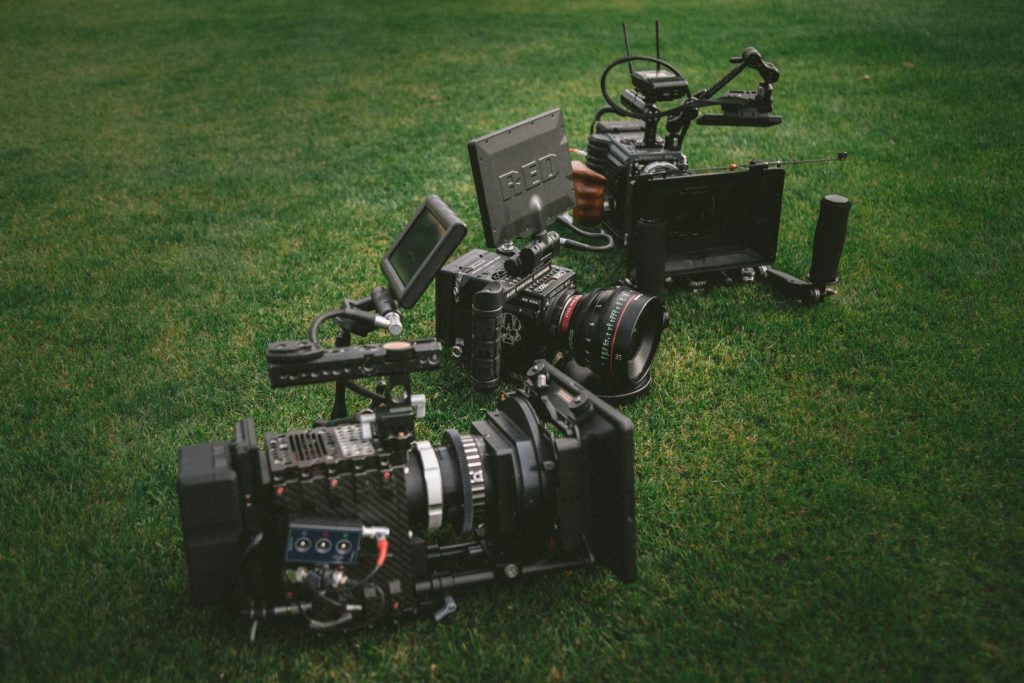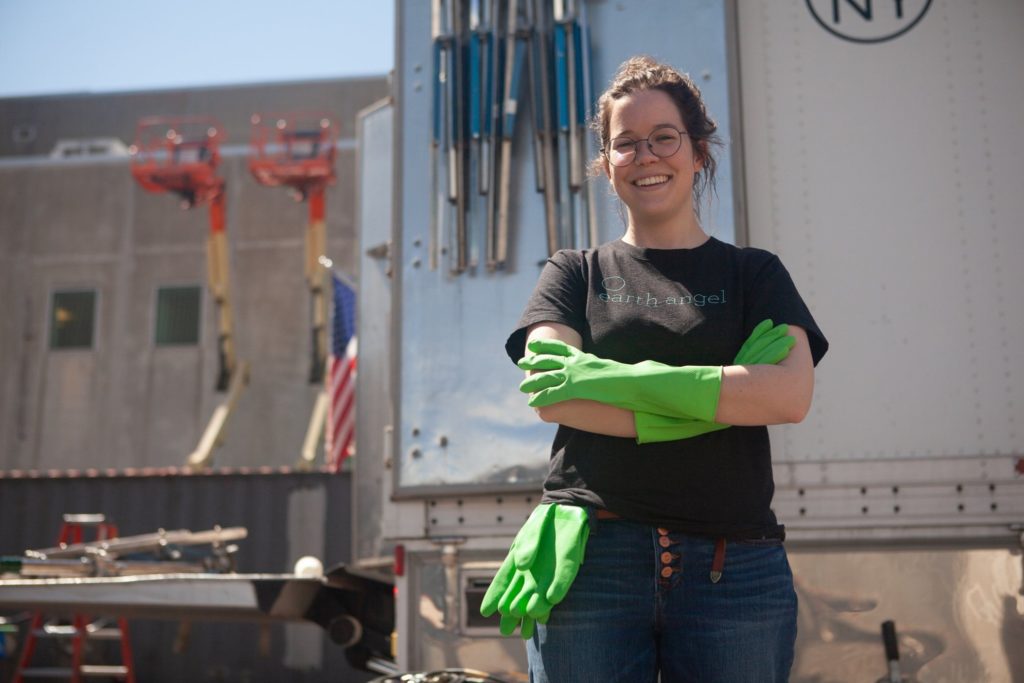The facts are in. The climate crisis is something that everyone is starting to take into consideration when making choices, from their everyday lives to the workplace. Sustainability isn’t necessarily something that is new to production sets, but in recent years it’s become a heavy point of focus in aiming for an environmentally friendly film. Producers are now planning around reducing the carbon footprint and waste left behind on production days.
Emellie O’Brien, Founder and CEO at Earth Angel, joined us to discuss a new trend in hiring for production crews in the industry: the Green P.A. More of a Green production coordinator, this crew member is in charge of making sure your production day is sustainable and low-impact. They’re today’s major player when it comes to building your production crew!

What is Earth Angel and its background in production and sustainability?
Coming from a background in film and TV at NYU, Emellie says she always wanted to make socially and environmentally conscious content, so for a long time she thought she’d do that by going the documentary route. She was put in charge of focusing on green initiatives when she got her first job in the film industry at Focus Features.
“It was the first time it dawned on me that there was any kind of intersection between entertainment and environment”
Emellie O’Brien
Through her experience at Focus Features and some extra research, it became evident that productions were willing to hire a specific crew member to “green” their set. This role had a variety of names however, from Green P.A to environmental steward. Emellie found a producer who hired her into this nameless role and, through word of mouth, was able to build it out to more and more productions aimed at producing an environmentally friendly film. This eventually included The Amazing Spiderman 2, which gained a ton of press for being the most eco-friendly blockbuster in recent years. Eventually Emellie found herself asking if there was more to this role, if it could be scaled out to get more “Earth Angels” on set – and that’s when the idea for Earth Angel came about.
Talking to Emellie, we were surprised we hadn’t ever heard of a role like this, and Emellie says the role has also sort of stemmed out of desperation to get into the industry. Being a Green P.A gets you on set, ultimately leading to more roles and experience, so not every Green P.A is as whole-heartedly set on the role like Emellie – at least at first.

Why you should pay to green your set.
Of course, with everything new to any industry, there is a level of education that must be done in order to convince potential studios and clients that this is a role that is worth paying for. Emellie says there is still a ton of education that she has to do in order for her clients to see the value, even with the urgency of the climate crisis.
“When I talk to people in the business world and tell them that I started a business that provides a service for which there is no market demand, they kind of look at me like I have three heads.”
Emellie O’Brien
She says a lot of her role as Earth Angel’s founder is begging producers to pay what they could to get the staff and resources together, and really trying to make it happen. It’s a labor of love in a lot of ways, so it can be a challenge to find people to consistently do this work. Sometimes people will try it once, then use it as a stepping stone, and never revisit the role again. Emellie knew they had to build a structure in order to retain people and to have a high level of talent and expertise that is needed to execute the role appropriately.
Is an environmentally friendly film realistic for every set, from independent to feature film production?
When it comes to adding an extra member to your production crew, we couldn’t help but think about the extra costs involved. In a lot of ways, it can be a privilege to be able to afford a sustainable work environment and home because green initiatives often come at a high price. Emellie says she gets this question a lot.
“Productions with less resources available are inherently more sustainable.”
Emellie O’Brien
Unlike television shows and films with multiple units, in multiple countries, flying around the world and constructing massive sets and wrecking cars, the indie film world is naturally more resourceful because it has to do more with less. These massive TV productions have to take extraordinary measures to stay sustainable because their footprint is just so high to begin with.
Want to know more about indie production? Check out our blog post!
There are still baseline actions that every production can take to stay eco-friendly, like eliminating single use plastics, and going paperless on set. Scroll through your app store and you’ll find plenty of apps available where you can source second hand materials, donate your materials when you’re done, and productions can also make a plan for reuse ahead of time. On an indie scale it can be even more doable, with less people to wrangle and educate.
“We work on shows where there are days with hundreds of extras, and trying to get them to compost and recycle correctly can be a challenge.”
Emellie O’Brien
Where Emellie says there needs to be improvement on set in measuring and tracking your footprint. A lot of studio productions are actually required to do a carbon footprint analysis after they’ve wrapped, but indie productions won’t necessarily have that requirement. Carbon tracking and environmental impact assessments are something that every production should be planning for, and tools to measure this data need to become more accessible. Earth Angel is still in the process of wrapping their brains around this challenge.

How do you measure your production’s environmental impact?
There are a few different tools that productions can use to track their carbon footprint, including one that is completely free and downloadable on greenproductionguide.com. It’s referred to as PEAR, which stands for Production Environmental Accounting Report. PEAR is essentially where you can input all of the utility information that your production has used (electric bills for set, production office, etc.), natural gas utilities and fuel consumption from scouts to generators and caterers.
Tracking your emissions data can get complicated and overwhelming, so one of the challenges is to find a way to make emissions reporting a natural part for the production process.
Then, what do you do with your carbon emissions data? It depends on what your goals are. With big productions, this data is sent to the corresponding studio who often has a corporate social responsibility or corporate sustainability reporting that they do at a high executive level. For small scale production, this data can be used to create sustainable goals for your next shoot and track your improvements from project to project.
What are Green PA’s thinking about?
Some of the big changes to come on set revolve around power sources, lighting, and set waste. Some studio facilities are already dedicated to using hydroelectric power and solar panels. Some simple steps to reducing your carbon footprint are to tie your basecamp and set into the grid and eliminate the use of generators. When it comes to lighting, talk to your gaffer and DP about some of the creative elements they’re going to use and encourage LED lighting.
“A lot of people have been discouraged to use LEDs because they couldn’t get that warm temperature that they so loved with traditional incandescent lighting. Most of these new LED models have technology that is so far advanced that you can hardly tell the difference”
Emellie O’Brien
We’re willing to bet any colourist will be happy to warm up your shots in post-production.
One of the things that we pride ourselves with at Set Scouter is how sustainable the concept of a location scouting market place truly is. Renting lived-in spaces allows productions to avoid the waste of set building and figuring out what to do set pieces afterward, something that Emellie says is another issue in sustainable production. With companies like Set Scouter, productions can avoid the costs and emissions from hauling set pieces in trucks, find and repurpose an authentic location and its contents, and eliminate set waste and the issue around environmentally friendly disposal solutions.
Otherwise, Emellie says, productions are building big, big sets and props that simply cannot be repurposed or donated.

Your next steps as an environmentally conscious creative
Name someone in your crew to be a leader in sustainability. Not every production can hire a green PA or sustainability consultant, but having someone who can hold your production accountable will be a big step in the right direction to not let green initiative to fall by the wayside.
Take advantage of free resources that are out there, there plenty on greenproductionguide.com, or you can contact your local environmental organizations to get free recycling signs and other tools that you can use on set and make that environmentally friendly film.
Stay informed, stay educated, and find ways to motivate yourself and team to keep green initiatives in mind. This is something that you can bring to not only the workplace, but also to your personal life and beyond. If you have an eco leader in each of your daily environments, good change is bound to be normal. That could be you!
Scout locations for your next sustainable production!

